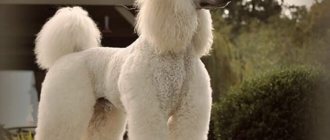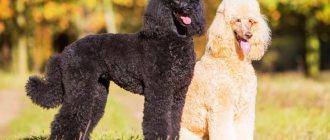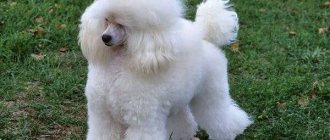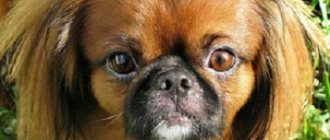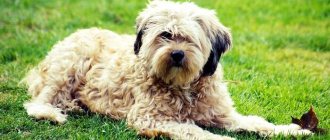Origin story
Poodles have a murky origin story. Traditionally, France is considered their homeland, but some researchers believe that the breed originated in Germany: the name poodle comes from the German puddeln, which means to splash.
Their possible ancestors are French and Portuguese water dogs, barbets and curly-haired herding breeds. There are known ancient coins and bas-reliefs depicting animals resembling poodles. In the 12th century, curly-haired dogs began to be depicted in frescoes of French monasteries.
In France, the poodle was considered a royal breed; commoners were forbidden to keep elite dogs. Those who violated the order faced severe punishment. Over time, the government lifted the restrictions, and poodles began to be used as hunting dogs: their thick, long hair allowed the dogs to retrieve birds from the water.
Poodles have always been popular as toy dogs. Their peculiar wool inspired barbers to create intricate hairstyles. The first dog groomers were opened in the 18th and 19th centuries. At the end of the 19th century, the first breed clubs appeared, breeding purebred poodles. Selection was carried out not only in France, but also in the USA, England, and Germany. German poodles were distinguished by their heavy bones, while American and English poodles were distinguished by fine bones and grace. This contributed to the emergence of several breed standards. In 1936, the French standard was officially recognized.
Dog health
Toy poodles are not a breed that gets sick often. But still, they are prone to a number of diseases. Among the diseases that can cripple a poodle are diabetes, periodontitis, glaucoma, and luxating patella.
A predisposition to a number of diseases does not mean that your pet will necessarily get sick with something. It is important to monitor his health, because any disease is easier to prevent than to treat.
You should definitely remove internal parasites from your pet at least once every three months. Nowadays, there are a large number of drugs for this purpose that are sold in veterinary pharmacies. These are tablets, pastes, suspensions, and even drops on the withers.
You should definitely vaccinate your poodle. This will help protect him from common diseases that any pet that goes outside can get.
It is also necessary to remove fleas from the animal. In addition to the fact that this is a rather unpleasant phenomenon, fleas are carriers of various diseases.
During the tick season, your pet needs to wear a collar that will protect him.
Types - brief description of the breed
Poodles are varied in appearance, color and coat type. The ICF recognizes the following sizes:
- standard/large: height from 45 to 60 cm;
- small: height from 35 to 45 cm;
- miniature/dwarf: height from 28 to 35 cm;
- toy poodle: height less than 28 cm.
The small species has a second name - medium poodle. The breed is also divided into varieties based on coat type: curly and corded.
Acceptable colors include:
- white;
- black;
- brown;
- apricot;
- silver;
- red;
- harlequin and tan (only in Russia).
The red color of the coat was not recognized by FCI members for a long time. In 2007, lovers of the fiery color achieved its registration.
The Poodle is a decorative dog with a lean build, the main feature of which is its lush, curly coat. General breed standard:
- Size: height from 28 to 60 cm, weight from 7.5 to 12 kg.
- The head has an elongated shape, the muzzle is narrow at the end. The occipital protuberance is well defined.
- The shape of the eyes is almond-shaped, the color of the iris is dark brown. Red, brown and apricot poodles have brown irises with splashes of amber. The corners of the eyelids are pigmented.
- The bridge of the nose is straight. The color of the lobe depends on the type of color: in white and black poodles it is colored black, in brown poodles it is colored coffee. Apricot and red colors produce black or brown color. A light colored nose is called a winter nose and is undesirable.
- The ears are low set, hanging, long with rounded ends. Fits well to the head. Their length reaches the lips.
- The neck is dry, moderately long, with pronounced muscles.
- The scruff of the neck is pronounced, the withers – weakly.
- The back is strong, rather short, and has a slight slope towards the croup.
- The belly is slender, toned, with an elegant curve.
- The tail is high set and straight. According to the standard, the tail should be docked by two-thirds.
- The forelimbs are positioned at a slight angle. They are strong and muscular.
The described traits should be present in all varieties of poodles, regardless of size or color. This breed is also characterized by dense pigmented skin. In dark-colored dogs, the pigmentation should match the coat color (primary).
Toy poodle
The toy poodle is a very popular decorative pet. Its pocket format does not affect mental abilities: this baby is easy to train. Its ancestors include the Sheep Poodle and the Spanish Water Dog. Any solid color is allowed, but preference is given to pure shades.
This variety is very difficult to maintain. Poorly trained dogs are prone to aggression, especially towards children. They also belong to the category of empty nesters, which means they can burst into loud barking at any moment.
Toy poodles require regular financial investments. They need a model haircut, clothes and quality food. In addition, they are suitable only for active owners.
One of the main disadvantages of the breed is its tendency to serious genetic diseases. Toys do not need contact with their relatives: they are human-oriented.
Miniature Poodle
The mini poodle has a phenomenal ability to train. It is often used in circus performances. This dog loves to do tricks. Sometimes owners think that their pet understands their speech. His coat is colored standard for the breed.
Mini poodles are true introverts. They don't like interacting with dogs or strangers. Dogs prefer to communicate only with the family in which they live. At the same time, they are not prone to aggression and can happily meet friends. These kids are very jealous: they do not like it when the owner shows sympathy for another animal. Toy poodles love attention and try to get it in a variety of ways.
Royal Poodle
Royal (same as large or standard) is the largest representative of the breed. Its long, curly coat can be rolled into cords or trimmed. Poodles are able to remember a command after three repetitions. Their high level of intelligence allows them to manipulate children and owners.
It is not recommended to trust small children (under 12 years old) to train a dog: the poodle will outwit the child.
Cocker Poodle (Cockapoo)
The Cocker Poodle is a cross between a Cocker Spaniel and a Poodle. It was developed in the 30s of the 20th century in the USA. Breeders wanted to get a poodle hybrid free from genetic abnormalities. The experiment turned out to be successful. Cockapoos grow up to 38 cm and weigh up to 15 kg. The coat is soft, with a wavy structure, reminiscent of the pile of spaniels. The color palette is very diverse: dogs can be red, red and white, black, white, cream, brown.
Cockapoos are attached to humans and have difficulty with separation. In general, the Cocker Poodle is indifferent to its relatives, but cases of the most sincere friendship are known. He does not show aggression towards children, but will not forgive them for careless treatment.
Cocker poodles are sensitive to their owner's mood. It is enough to slightly change the intonation for the dog to understand whether he is being praised or scolded. This breed is prone to barking for no reason. Some of its representatives can be nervous and jealous.
Varieties of colors
The coat of these dogs is elastic, thin, and thick. It can be curly with even curls or form characteristic cords up to 20 cm long.
According to the standard, the description of the breed includes several shades of hair:
- brown or black (tar) poodle – attracts serious, practical people;
- a white pet requires constant attention to keep its coat in order;
- apricot (peach), red (red) looks decorative, varies within the indicated limits, including orange, pink tone;
- gray coat color.
For all varieties of the breed, the color of the coat should be uniform and uniform. The skin pigmentation in white dogs is silver, while in other poodles it corresponds to the coat.
There are other dog colors recognized in Russia - tan, black and white harlequin. Non-standard ones include silver-beige, cream, blue, brindle, sable with dark tips of hair, splash with light spots on the coat.
Character
Poodles are distinguished by their sharp intelligence and devotion to their owner. These are active, obsequious and cheerful animals. Poodles love to fool around and play outdoor games. It is believed that females are smarter than males and are preferable as companions. They are affectionate and sensitive, adore their owners. In addition, they pick up any commands on the fly and are easily toilet trained. Males have a more impressive appearance and are prone to aggression, so increased attention is paid to their training.
With proper upbringing, the poodle and children turn into best friends. Some dogs prefer to interact with teenagers. It can be difficult for a child under the age of 12 to train a poodle. The pet will try to outwit him and benefit from it.
This breed requires special attention. People who work a lot should choose another dog. If a poodle is not interacted with enough, it becomes withdrawn and aggressive.
Poodles are not prone to zoo aggression. They get along well with cats and other dogs because they prefer to communicate with their owner. But there are examples of their tender affection for animals.
This breed is artistic and loves to be the center of attention. In addition, large poodles can be raised to be full-fledged defenders. They have developed bodyguard instincts and will be able to repel an attacker. Even miniature representatives of the species will greet a stranger with a piercing bark. Poodles will reciprocate their love for a loving owner and will be devoted to him until the end of their lives.
Predisposition to disease
Representatives of this breed are considered long-lived among dogs. Some individuals live up to 18 years. However, it is very important to maintain a healthy lifestyle for your pet. He needs walks and activity, as well as proper nutrition and a balanced diet.
Genetic predispositions:
- Fusion of the nasal passages. Sometimes found in dwarf individuals with complications of varying degrees. If this bothers the dog, surgery cannot be avoided.
- Retinal atrophy.
- Cardiovascular diseases.
Care and maintenance
The main feature of the poodle is the absence of undercoat. This makes him an ideal apartment dog. Also, the dog does not have a dog smell and is suitable for allergy sufferers. Another unusual quality is the absence of shedding. This involves regular grooming (every 1.5 months) and haircut. In addition, an unclipped poodle is not allowed to participate in exhibitions, but can participate in breeding.
Few people know that the traditional lion haircut used to be functional. All the hair was shaved off the paws to make it easier to stay in the water, a fluffy vest protected the organs from hypothermia, a pompom on the tail protected it from thorny plants, and a bow collected wet hair on the top of the head.
The Poodle is one of the breeds for which a hygienic grooming is not enough. Regular visits to the groomer will benefit your dog's coat. There are a huge number of haircuts: each country has its own standards. Unfortunately, grooming is expensive, so you need to know how to trim your poodle at home. To do this, you will need a brush with a rubberized base, a slicker brush with a smooth curve, hairdressing scissors, a tangle cutter and a comb with rounded teeth.
Poodles need to be brushed daily to remove dead hair. Dogs are bathed as needed, but special products can be used no more than 3-4 times a year.
Shampoo for a poodle should be premium or super premium and belong to the professional line. Be sure to use conditioner.
To prevent the coat from getting wet during walks, the poodle will need clothing. It is better to give preference to raincoats and waterproof overalls. This will protect your pet from moisture and prevent its fur from getting dirty. For the winter, the dog is given insulated overalls.
Ears are cleaned once every two weeks. The ears are wiped with a cotton swab dipped in warm water, or cleaned with a special lotion. To avoid oral diseases, brush your teeth at least once a week. Nails are trimmed 2 times a month. Eyes are cleaned as needed. To do this, use a cotton pad soaked in chamomile infusion or warm water. Movements should be directed towards the corner of the eye. The first vaccination is given to the puppy at 2 months of age. Before this, anthelmintic treatment is carried out.
Nutrition
The poodle can be fed high-quality dry food or meals made from natural products. The choice of food type depends on the capabilities and desires of the owner. It is very important to stick to one feeding system all your life.
Adherents of natural food should include the following products in the poodle’s diet:
- lean meat: beef, turkey and chicken;
- well-cooked offal: beef and chicken tripes, heart, boiled pig ears, etc.;
- raw bones;
- sea fish (1-2 times a week);
- boiled egg (1-2 per week);
- buckwheat, rice, barley, pearl barley;
- cottage cheese, kefir, yogurt, natural yogurt;
- vegetables: pumpkin, carrots, zucchini, cucumber, radish, a small amount of beets;
- fruits: green apples and unsweetened pears;
- unseasoned croutons and meatless crackers;
- 1 clove of garlic per week;
- greenery.
List of prohibited products:
- fatty meat (pork);
- tubular and boiled bones;
- legumes;
- potato;
- milk;
- sausages and confectionery products;
- products made from yeast flour;
- fried, salty, spicy;
- seasonings and spices;
- grape;
- plums;
- raisin;
- apricots.
An adult dog is fed 2 times a day. Meat should make up two thirds of the daily portion. It can be given raw, scalded with boiling water or boiled. Raw defrosted meat is especially useful. By-products have lower energy value, so their quantity is increased by 50-75% of the usual serving of meat. By-products can only be given thermally processed.
Sea fish is served both raw and boiled. River water - only boiled (it may contain worm eggs). Before serving, remove the gills, head, fins, entrails, bones and tail. Babies under 3 months of age are given only boiled fish, without scales.
Feeding natural foods requires taking mineral supplements. Otherwise, the animal will suffer from a lack of nutrients.
Modern super-premium dry food is made from whole meat and natural ingredients, which means it provides a healthy, well-balanced diet. In addition, drying contains all the necessary vitamins and does not require mineral supplements.
Premium and economy class feeds are made on the basis of by-products and cereal fillers, which cause allergic reactions. While premium food may contain whole meat, the economy version contains only by-products and waste from slaughterhouses. Cheap food causes poisoning, allergies, urolithiasis and other disorders.
Quality feeds include:
- Brit Kea;
- Pronature;
- Original;
- First Choice;
- Dukes Farm;
- Monge;
- Akana;
- Grandorf;
- Now Fresh;
- Savarra.
These manufacturers produce food for dogs of different ages and sizes, and the last 4 items on the list refer to hypoallergenic food - holistic. Recommendations for the daily serving size can be found on the packaging or the manufacturer’s website.
The animal must have constant access to clean water.
Feeding the puppy
In the first 4 weeks, the baby feeds on mother's milk. At the age of 1.5 months, semi-liquid semolina porridge, calcined cottage cheese, scraped beef, grated carrots, vegetables and lean crackers can be introduced into his diet. Approximate serving size: 2-3 tbsp. l. Milk can be given no more than 4 tbsp. l.
From 3 to 6 months, the puppy is fed oatmeal porridge, finely chopped beef, calcined cottage cheese, grated vegetables, and soft raw bones. Raw egg yolk is also included in the diet. From 7 months the puppy can eat adult food.
If the owner decides to raise the puppy on dry food, he can introduce it at the age of 1.5 months. The main thing is to soak the granules in milk or warm water until the puppy can chew them. Feeding regimen: puppies aged 1-3 months are fed 6 times a day, from 3 to 6 - 4, from 6 to 12 - 3, after a year - 2.
How to choose a puppy
The choice of poodle puppies is quite wide, due to the differences in their color and size. It is worth considering that you should not take a miniature (dwarf) or toy poodle into a family with a baby, since dogs from this category often suffer from childhood awkwardness. The choice of color depends on subjective preferences. One litter can have poodles of different colors.
Poodle grooming
During a visit to a breeder, in whose reputation you, of course, should be confident, do not rush to immediately purchase the first puppy you like, but observe its behavior. Healthy poodle puppies are always active and playful, and among them you need to choose the most active and curious one. Please note that females are generally calmer.
If you decide to opt for a miniature or toy poodle puppy, do not buy the smallest one: it may also be the weakest.
Check the poodle's eyes - they should be clean, without accumulation of secretions in the corners. It is also necessary to examine the tummy for rashes and redness. Do not neglect to check the condition of the hair under the tail: if it is stuck together, it is likely that the dog has digestive problems. The dog should not itch or limp.
Even purebred white poodles may have cream or apricot areas of fur on the chest, ears, and lower limbs - this is not a defect of the breed; with age, the fur will turn white. It happens that puppies are born with pink noses and paw pads, but over time these areas darken.
It is preferable to purchase poodle puppies when they are already 2 months old. If you want your chosen one to take part in exhibitions in the future, he must be at least four months old.
The breeder must give you a puppy card, which can then be exchanged for a pedigree, and a veterinary passport with vaccination records.
Photos of poodle puppies
Education and training
After the puppy arrives in a new home, he is taught the rules of behavior and indicated his position in the hierarchical ladder. If a baby imagines himself to be a leader, he will not obey his owner well. This applies to dogs of all sizes.
You should not allow the puppy to beg or steal food from the table, chew the owner’s things, or ask for bed. Some poodles take a long time to get used to the toilet outside, so you need to patiently raise the baby.
At home, you can easily teach your puppy standard commands. Training should be based on encouragement. The poodle will support any initiative of the owner and perceive training as an exciting game.
Under no circumstances should you physically punish your dog.
If the owner wants to use the poodle’s abilities 100%, he should enroll him in a general training course. Large poodles can undergo guard duty training.
Feeding
Feeding a miniature poodle is no different from feeding any other breed. You just have to decide on its type. If you prefer dry food, you must definitely choose food of at least a premium class.
When feeding naturally, you need to think about your pet’s diet. The main component should be meat. A couple of times a week you can replace meat with sea fish. Be sure to add porridge, fruits and vegetables, fermented milk products and eggs, and vegetable oil.
Fatty foods should be excluded from your pet's diet.
The sensitive liver of a poodle will definitely react not in the best way to imbalances in nutrition.
It is necessary to strictly control the dog's portion without overfeeding it. This applies to any type of feeding.
It is under no circumstances recommended to mix dry food and natural products.
How much does it cost and where to buy
The poodle is one of the most popular breeds in the world, so finding an officially registered kennel is not difficult. You should not buy babies from your own hands: this risks genetic diseases and mental disorders. In addition, breeders who keep dogs in terrible conditions should not be encouraged. A specialized nursery guarantees basic social skills and the absence of defects.
List of nurseries:
- Aqua Vite (Omsk);
- Amore Bello (Volzhsky);
- Answell (Nizhny Novgorod);
- Volzhskaya Platinum (Samara);
- Vyatka souvenir (Kirov);
- Gold Standard (Moscow);
- De Luvis (Lipetsk);
- Delight Expression (Tomsk);
- Lumiere Dynasty (St. Petersburg).
Average price for puppies: 23,000-40,000 rubles. The cost of show puppies can reach up to 80,000 rubles.
Nicknames for male poodles: Archie, Cupid, Spike, Barney, Chuck Charlie, Simba, Ernie, Pirate, Umka, Twix, Simon, Parker, Ricci, Courage. Nicknames for girls: Jessie, Holly, Petty, Molly, Gerda, Dolly, Pixie, Toffee, Thea, Kira, Minnie, Nika, Alice, Roxy.
List of nicknames
When choosing a suitable name for a poodle, owners focus on external characteristics, behavioral skills and their own preferences.
Popular nicknames for boys:
- Ice, Cupid, Apollo, Archie, Buggy, Bucks, Baron, Bim, Bont;
- Duke, Gray, Gucci, Jack, Jerry, James;
- Kai, Clyde, Claude, Larry, Leo, Mike, Montin;
- Nice, Nick, Nortis, Onyx, Oscar;
- Plato, Pele, Persian, Fluff;
- Rich, Rolf, Simon, Skif, Smile, Spikey, Sultan;
- Teddy, Fry, Heidi, Chucky, Charlie, Shah, Eric, Ernie.
Nicknames for girls:
- Isa, Alma, Bertha, Bessie, Beta;
- Dana, Jessie, Dina, Dolly, Vega, Venus, Vesta;
- Gabi, Gerda, Gloria, Diya, Doxie, Dosya;
- Zara, Zita, Zlata, Kenya, Cleo;
- Laura, Molly, Nika, Ollie;
- Sally, Selina, Stacy, Sandy, Susie;
- Terry, Thea, Tosya, Ulma, Chita, Sherry;
- Alice, Elsa, Emmy, Utah.
Pros and cons of the breed
| + | – |
| Great companion | Some dogs are prone to aggression |
| Can be used as a guard and hunting dog | Wool requires regular and expensive care |
| Ranks second on the list of the world's smartest dogs | Tendency to genetic diseases |
| Excellently trainable | Does not tolerate separation from owner well |
| Good with children | Suitable for active owners only |
| Can get along with cats and other dogs | |
| Suitable for apartment living | |
| Long life expectancy | |
| No shedding | |
| Suitable for allergy sufferers |
The Poodle is an intelligent and loyal dog. He has a striking appearance and artistic talents. HE will become a devoted friend for creative and active people. A trained dog will be an excellent protector and will be able to stand up for its owner.
Breeding
Female poodles reach sexual maturity at 6 months, and males at 12 months. Knowledge of such characteristics of the breed requires careful monitoring to prevent early mating.
The optimal period of maturity for dogs of any gender is considered to be at least one and a half years old. Females come into heat twice a year. Mating of dogs is carried out 9 days after its start. Animals must first undergo a veterinary examination and receive vaccinations.
Expert opinion
Anna Abramenko
An avid dog lover. Experience in veterinary medicine since 2009.
Ask a Question
During pregnancy, which lasts 58-63 days, the dog is provided with a balanced diet and, if necessary, calcium supplements are given. Walks with reduced physical activity are mandatory for your pet.
For childbirth, a secluded place is prepared, to which the dog is trained in advance. The most convenient are special boxes installed in a separate room, where the female will not be disturbed by external noise. Oilcloth and clean, moisture-permeable bedding are placed in them.
If the course of labor is favorable, the dog copes independently, but the presence of the owner is mandatory. If necessary, it will help a poodle puppy that walks with its legs be born faster, or rupture the amniotic sac if the bitch did not have time to do this.
On the eve of whelping, it is advisable to agree with a veterinarian who will provide the necessary assistance in case of possible complications.
Newborns are cuddled after the umbilical cord is tied and breathing is restored, and they are applied to the dog’s nipples. Make sure all pets eat enough. On day 4, the tails are docked, leaving 1.3 to 1.2 lengths. After two weeks, babies begin to be introduced to complementary foods.
Reviews
Owners usually note the positive qualities of poodles.
Elena, Moscow: “This is a majestic royal breed that requires constant adoration, attention and care. If your pet’s fur is kept in order, then it’s impossible not to admire this magnificent creature.”
Kristina, Voronezh: “I always dreamed of being a stylist. Surprisingly, after buying a poodle, she was able to realize her creative ideas. The dog’s haircuts turn out great, and there are even regular clients from among the owners of similar pets.”
Snezhana, Kemerovo region: “My miniature poodle is 2 years old. I would like to note that this dog is an unsurpassed friend, protector, and comrade-in-arms. The dog feels everything, understands, is always ready to play pranks, go for a walk, run. Outwardly it looks like an expensive, unique toy.”
Video
* We invite you to watch a video about the Poodle . In fact, in front of you is a playlist in which you can select and watch any of 20 videos about a given dog breed by simply clicking on the button in the upper right corner of the window. In addition, the material contains quite a lot of photos. By looking at them you can find out what a Poodle looks like.
In this article:
|
Poodle cost
This is interesting: What determines the price of a poodle puppy in Russia
Dimensions do not have a significant impact on the price of the dog.
It varies from 15 to 45 thousand rubles. Higher rates are due to the titles of the pet's parents.
Selection rules
Having decided to get a poodle, they immediately decide on the size of the dog.
Miniature varieties are not suitable for families with small children. They, playing with the dog, can injure its fragile bones.
Expert opinion
Anna Abramenko
An avid dog lover. Experience in veterinary medicine since 2009.
Ask a Question
Medium-sized breeds are recommended for older people. A large poodle will satisfy the needs of hunters and active sports people.
When examining poodle puppies, pay attention to the following indicators:
- activity;
- clean eyes without streaks;
- straight, strong limbs;
- no rashes on the stomach;
- snow-white sharp teeth;
- silky soft wool without tangles;
- large ears without dirt inside.
When trying to purchase a dog for exhibition activities, they check the pedigree.


